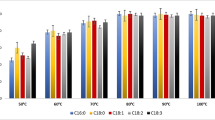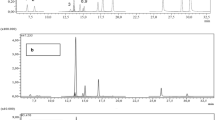Abstract
Most of the papers that treat the composition of essential oils for this purpose use GC/MS or GC/MS and GC/FID techniques for the identification and/or quantification of individual compounds. Therewithal, papers usually treat the composition as semiquantitative (percentage composition as the area of the peak of a particular compound in relation to the total area of the peaks on the chromatogram, given as 100 %). At the same time, the quality of the results is not treated in metrological terms. A GC/MS method for the quantification of components present Helichrysum italicum hydro-distilled essential oil samples from Bosnia and Herzegovina with a similar composition was developed and optimized. The stability of the method setup and adequacy of sample storage and manipulation were assessed. Calibration method and assessment of measurement uncertainty were established for neryl acetate, one of the major compounds with known health benefits.

Similar content being viewed by others
Data availability
The data used to support the findings of this study are included within the article.
References
Ćavar Zeljković S, Šolić ME, Maksimović M (2015) Volatiles of Helichrysum italicum (Roth) G. Don from Croatia. Nat Prod Res. https://doi.org/10.1080/14786419.2015.1009458
Perrini R, Alba V, Ruta C, Morone-Fortunato I, Blanco A, Montemurro C (2009) An evaluation of a new approach to the regeneration of Helichrysum italicum (Roth) G. Don, and the molecular characterization of the variation among sets of differently derived regenerants. Cell Mol Biol Lett. https://doi.org/10.2478/s11658-009-0007-3
Chinou IB, Roussis V, Perdetzoglou D, Loukis A (1996) Chemical and biological studies on two Helichrysum species of Greek origin. Planta Med. https://doi.org/10.1055/s-2006-957914
Hellivan PJ (2009) Immortelle’s sustainable resurgence “New research into the chemistry and application of this "everlasting" natural”. Perfumer &flavorist. https://img.perfumerflavorist.com/files/base/allured/all/document/2009/04/pf.PF_34_05_034_06.pdf
Ninčević T, Grdiša M, Šatović Z, Jug-Dujaković M (2019) Helichrysum italicum (Roth) G. Don: taxonomy, biological activity, biochemical and genetic diversity. Ind Crops Prod. https://doi.org/10.1016/j.indcrop.2019.111487
Paolini J, Desjobert JM, Costa J, Bernardini AF, Buti Castellini C, Cioni PL, Flamini G, Morelli I (2006) Composition of essential oils of Helichrysum italicum (Roth) G. Don fil subsp. italicum from Tuscan archipelago islands. Flav Fragr J. https://doi.org/10.1002/ffj.1726
Maksimovic S, Tadic V, Skala D, Zizovic I (2017) Separation of phytochemicals from Helichrysum italicum: an analysis of different isolation techniques and biological activity of prepared extracts. Phytochemistry. https://doi.org/10.1016/j.phytochem.2017.01.001
Uniyal A, Tikara SN, Agrawal OP, Sukumaran D, Veer V (2016) Quantitative evaluation of essential oils for the identification of chemical constituents by gas chromatography/mass spectrometry. Archives of Agriculture and Environmental Science. Retrieved from https://journals.aesacademy.org/index.php/aaes/article/view/aaes-01-01-04
Aşkun T, Başer KHC, Tümen G, Kürkçüoğlu M (2010) Characterization of essential oils of some salvia species and their antimycobacterial activities. Turk J Biol. https://doi.org/10.3906/biy-0809-2
Sneddon J, Masuram S, Richert JC (2007) Gas chromatography-mass spectrometry-basic principles, instrumentation and selected applications for detection of organic compounds. Anal Lett. https://doi.org/10.1080/00032710701300648
JCGM 100:2008, Evaluation of measurement data—guide to the expression of uncertainty in measurement. BIPM. https://www.bipm.org/documents/20126/2071204/JCGM_100_2008_E.pdf
Crowder S, Delker C, Forrest E, Martin N (2020) Introduction to statistics in metrology, chapter 10. Springer, Berlin
Morrison FA (2014) Obtaining uncertainty measures on slope and intercept of a least squares fit with Excel’s LINEST, M.T. University, Ed. https://pages.mtu.edu/~fmorriso/cm3215/UncertaintySlopeInterceptOfLeastSquaresFit.pdf
Lemaire G, Olivero M, Rouquet V, Moga A, Pagnon A, Cenizo V, Portes P (2022) Neryl acetate, the major component of Corsican Helichrysum italicum essential oil, mediates its biological activities on skin barrier. PLoS ONE. https://doi.org/10.1101/2022.04.29.490077
Zheljazkov VD, Semerdjieva I, Yankova-Tsvetkova E, Astatkie T, Stanev S, Dincheva I, Kačániová M (2022) Chemical profile and antimicrobial activity of the essential oils of Helichrysum arenarium (L.) Moench. and Helichrysum italicum (Roth.) G. Don. Plants (Basel). https://doi.org/10.3390/plants11070951
Mastelić J, Politeo O, Jerković I (2008) Contribution to the analysis of the essential oil of Helichrysum italicum (Roth.) G. Don. determination of ester bonded acids and phenols. Molecules. https://doi.org/10.3390/molecules13040795
Barwick VJ, Ellison SLR (1999) Measurement uncertainty: approaches to the evaluation of uncertainties associated with recovery. Analyst. https://doi.org/10.1039/A901845J
ICH guideline Q2(R2) on validation of analytical procedures (2022) EMA/CHMP/ICH/82072/2006 Committee for medicinal products for human use. https://www.ema.europa.eu/en/documents/scientific-guideline/ich-guideline-q2r2-validation-analytical-procedures-step-2b_en.pdf
Acknowledgements
This research was funded by and conducted in the laboratories of the Institute of Metrology of Bosnia and Herzegovina.
Author information
Authors and Affiliations
Contributions
KH-V and VM originally designed the experiments, did calculations and wrote the main manuscript text. MK performed GCMS measurements. MA and JK supervised the findings of this work.
Corresponding author
Ethics declarations
Conflict of interest
The authors declare that they have no conflicts of interest.
Additional information
Publisher's Note
Springer Nature remains neutral with regard to jurisdictional claims in published maps and institutional affiliations.
Rights and permissions
Springer Nature or its licensor (e.g. a society or other partner) holds exclusive rights to this article under a publishing agreement with the author(s) or other rightsholder(s); author self-archiving of the accepted manuscript version of this article is solely governed by the terms of such publishing agreement and applicable law.
About this article
Cite this article
Hafner-Vuk, K., Milojević, V., Avdić, M. et al. Improvement of the quality of analytical results generated by GC/MS method for characterization of Helichrysum italicum (Roth) G. Don essential oil. Accred Qual Assur 28, 261–270 (2023). https://doi.org/10.1007/s00769-023-01553-y
Received:
Accepted:
Published:
Issue Date:
DOI: https://doi.org/10.1007/s00769-023-01553-y




